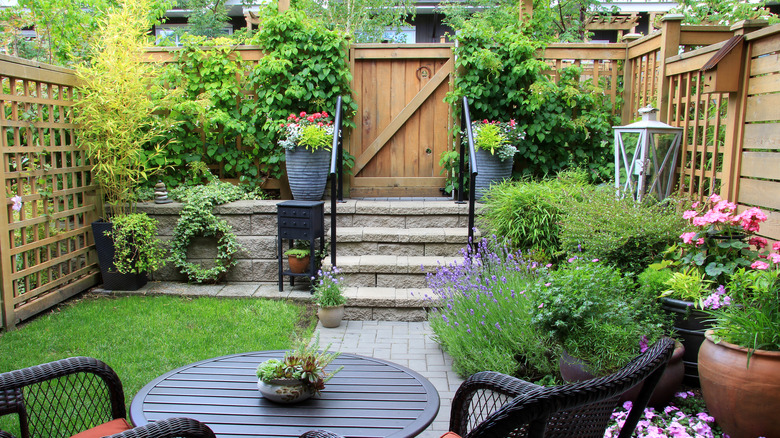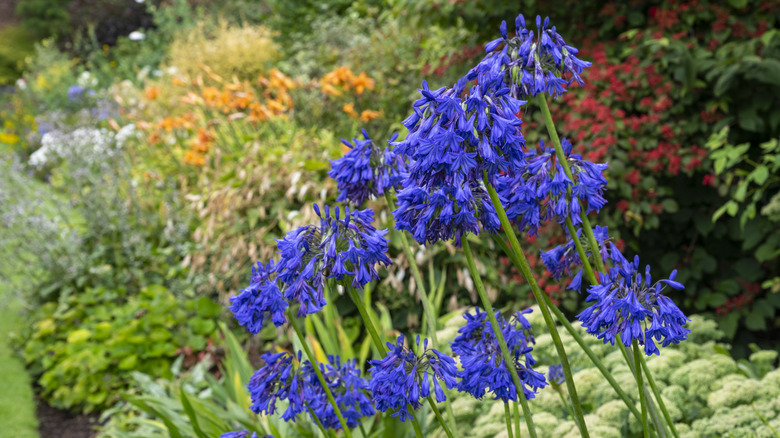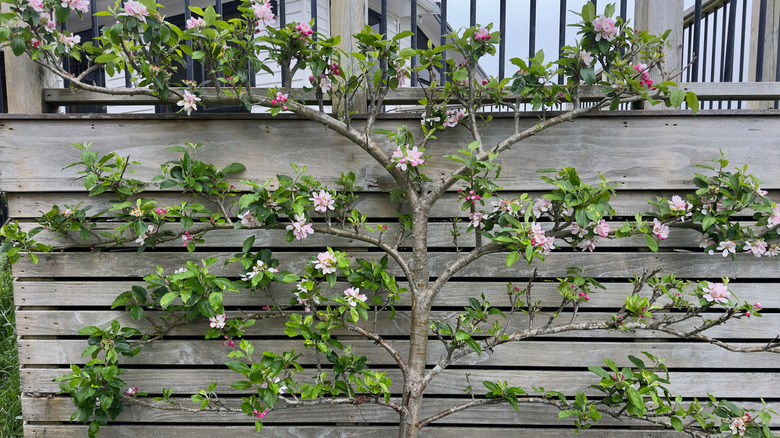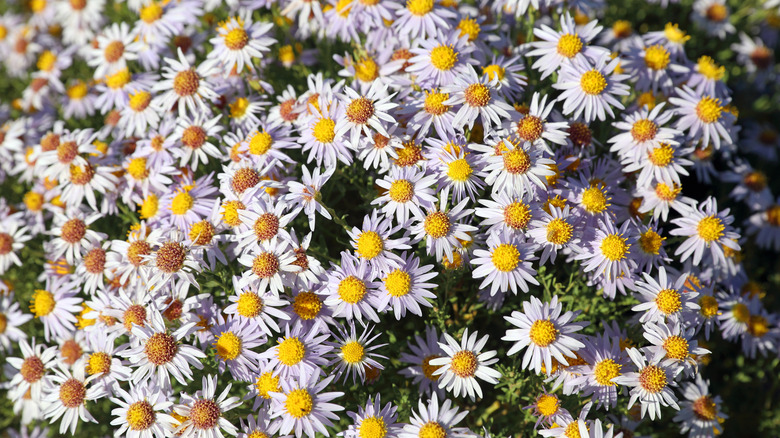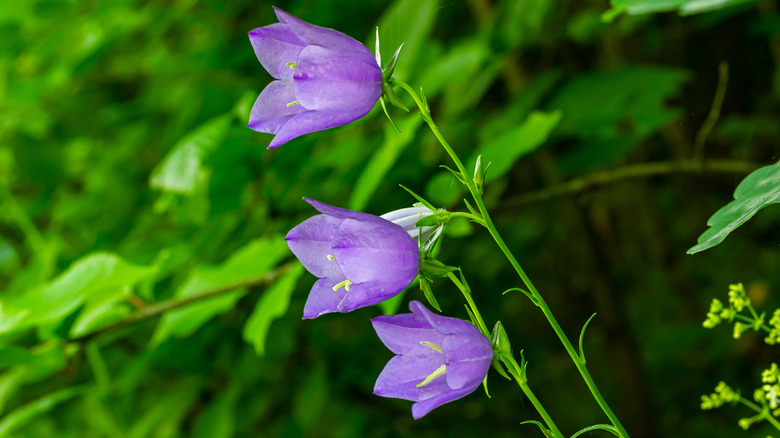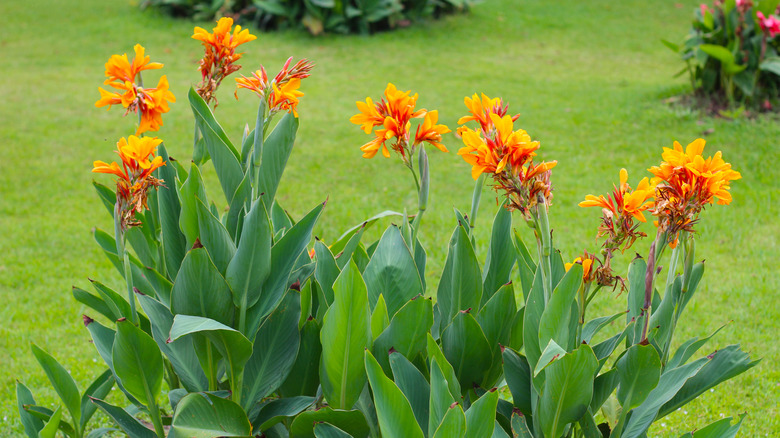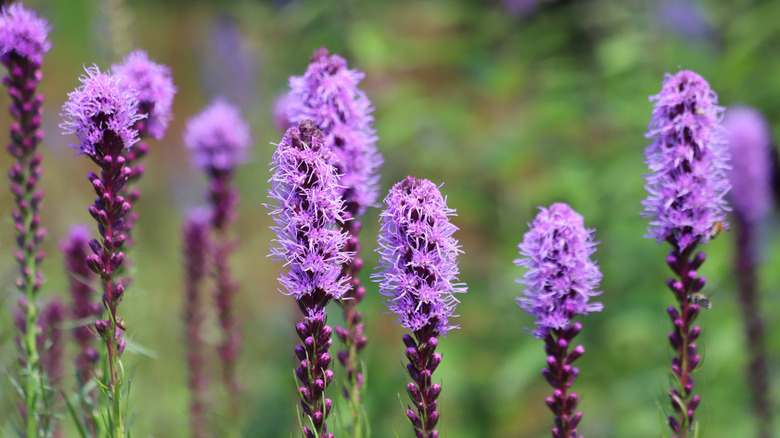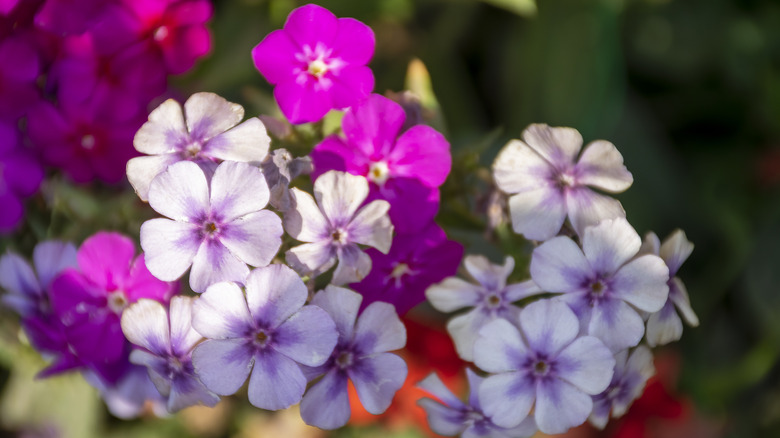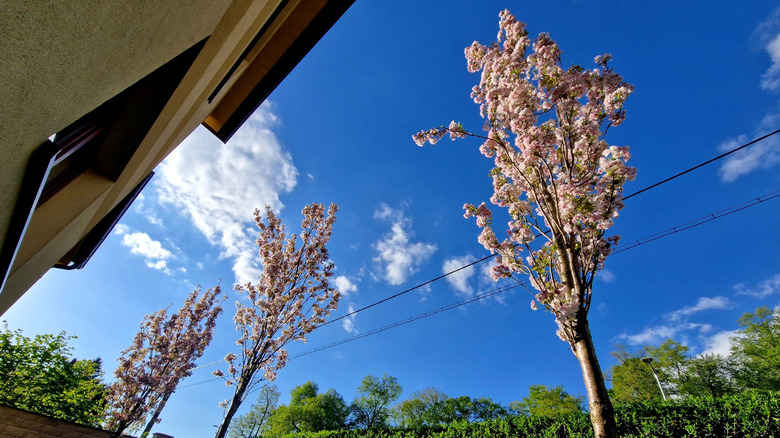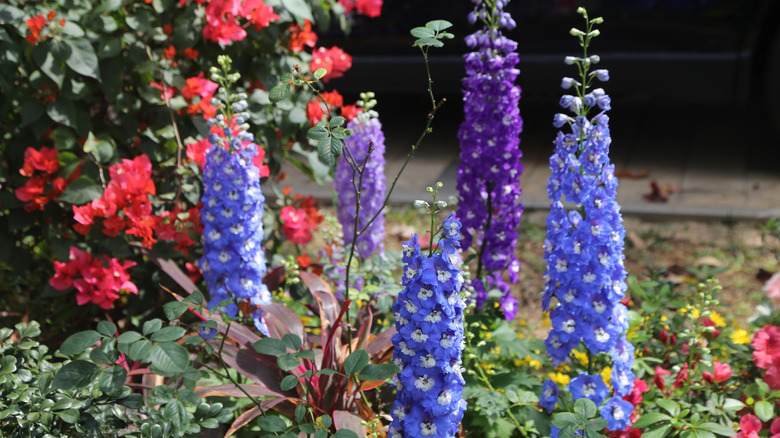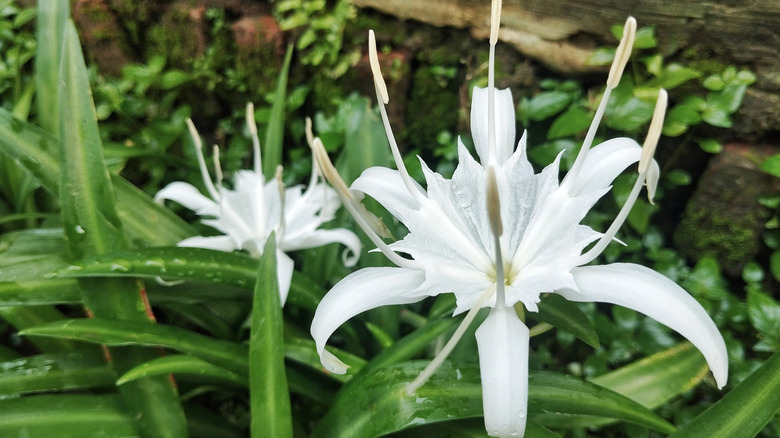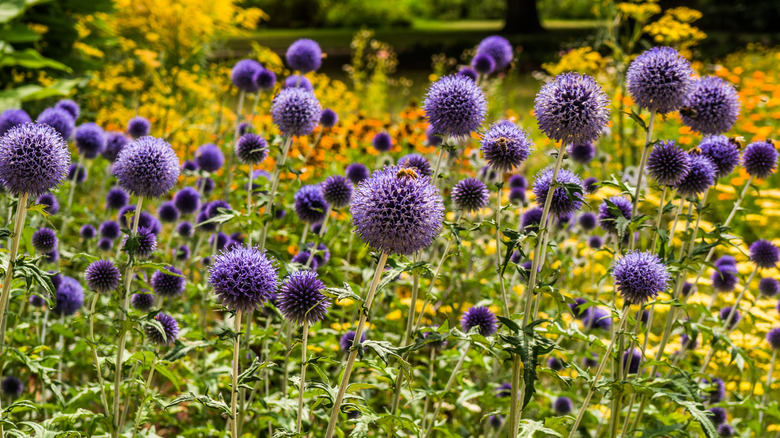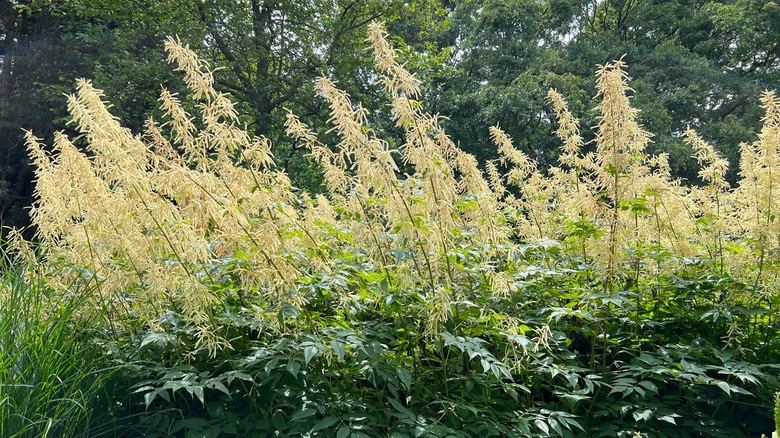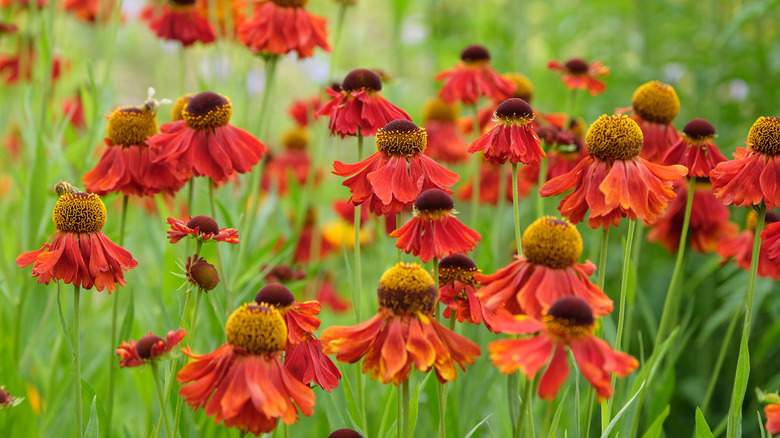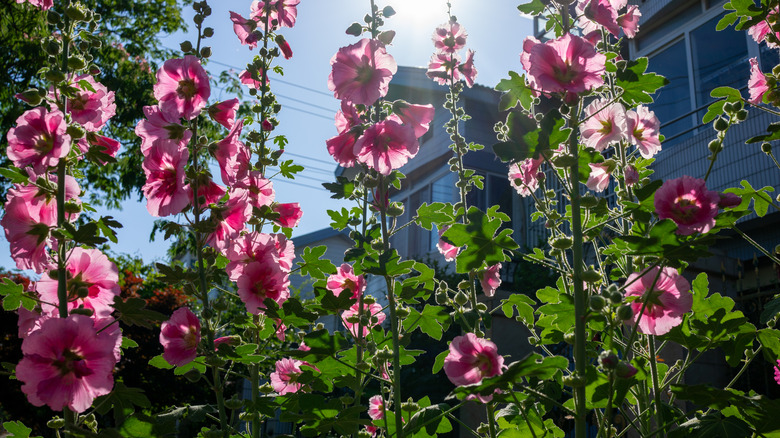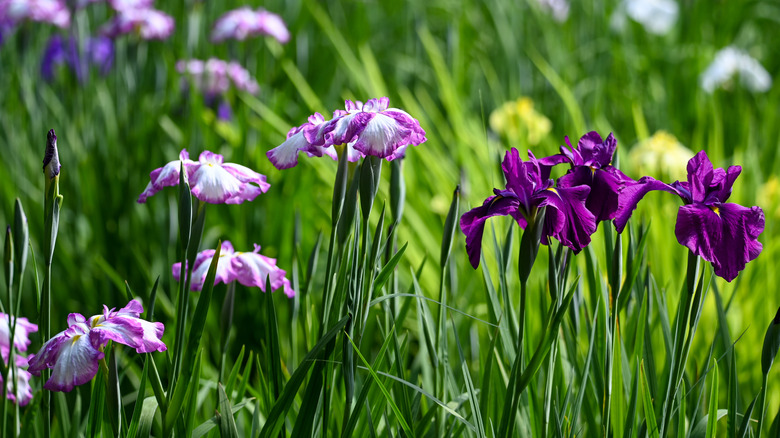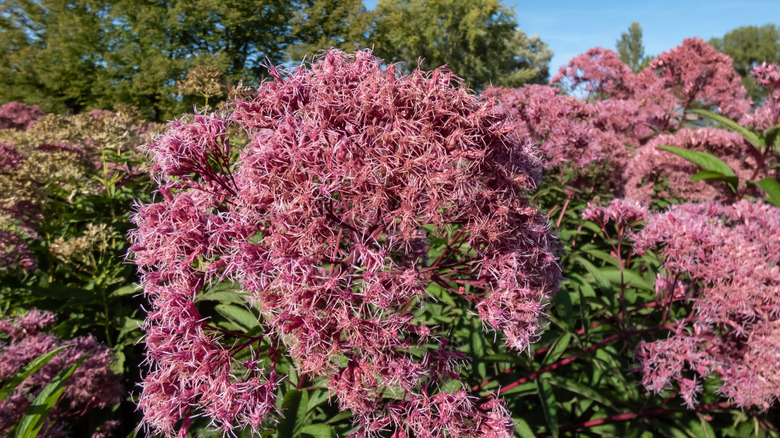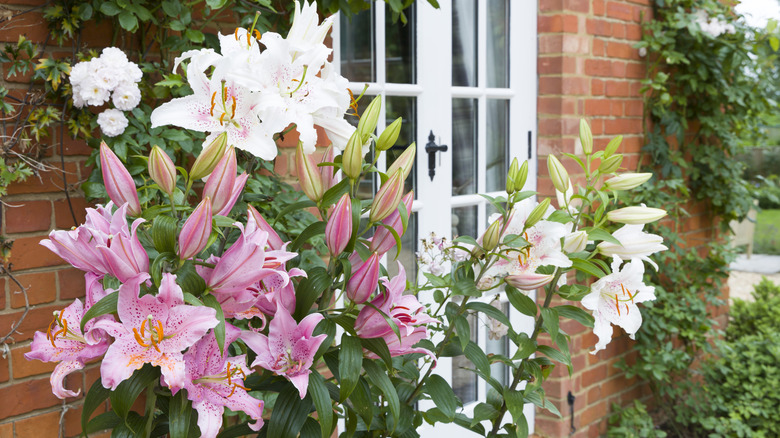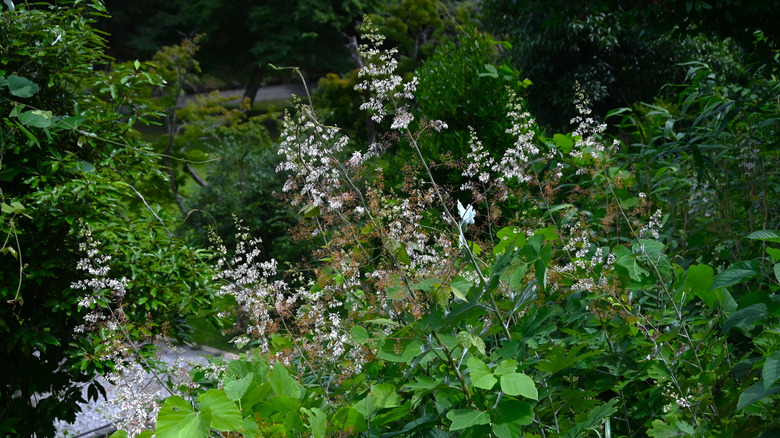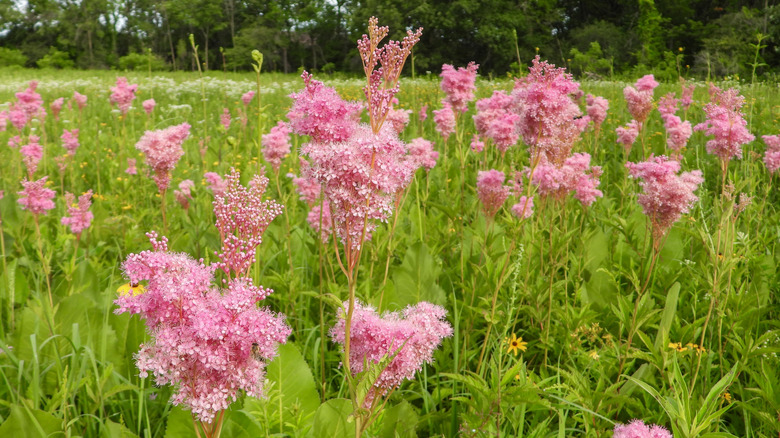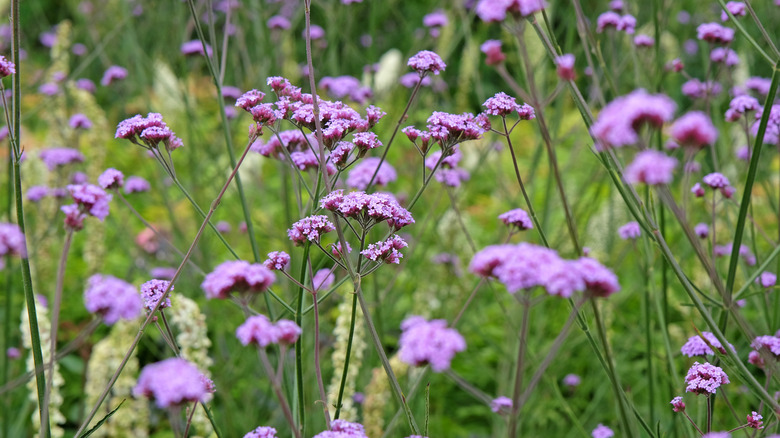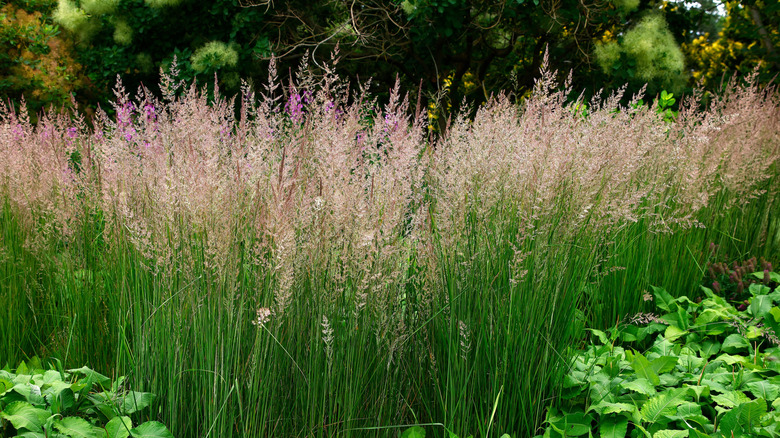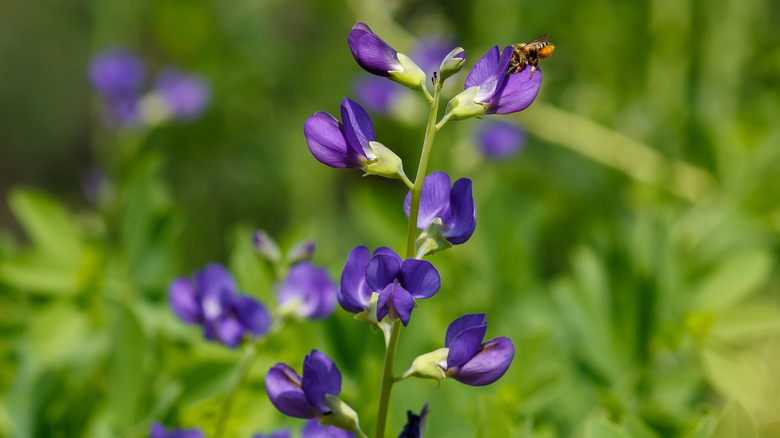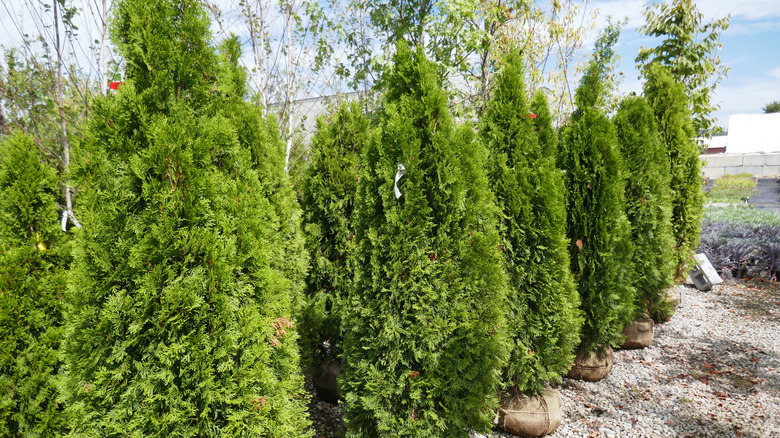24 Tall-Growing Plants And Flowers That Will Transform Your Small Garden
Everyone should enjoy leafy, blooming things in summer, even if you have a small yard or garden. Towering flowers and trees aren't limited to botanic gardens and suburban swaths. Narrow plants with some elevation can make even a postage stamp of a garden spectacular. Luckily, there is an abundance of tall plants for varying climates that can make a yard pop, whether you're in Fairbanks or Fort Lauderdale.
Shelve your fears that tall plants will overwhelm a small yard. So what if they do? It's all the better, since, for most of us, we have too short of a window for reveling in the growing season. Plant up an explosion of plants that will bring you plenty of smiles as well as pollinators and neighborhood admirers.
While none of these plants is listed among invasive species in the U.S., a couple have spreading tendencies that you should keep in mind. Among these compiled flowers, grasses, and trees, you're sure to find at least one alluring species that will be the right fit for your undersized outdoor space.
Agapanthus
Agapanthus (Agapanthus spp.) also goes by much more romantic names like African lily and lily of the Nile. The flowers on this dramatic perennial look like miniature fireworks: Sprays of trumpet-shaped blossoms radiate from a head atop a thin, graceful stem. Plus, pollinators go nuts for agapanthus. There are quite a few varieties to choose from, ranging from white to many gradients of blue. Go for truly oversized with 'Ellamae' that reaches up to 5 feet in height, or dial it down a bit with the 8-inch-tall 'Blue baby'. Agapanthus thrive in USDA Hardiness Zones 8 to 11.
Espalier fruit tree
Give your yard some French flair with fruit tree grown "espalier" style. Fruit trees trimmed and trained so that all of the branches grow flat against a vertical surface have saved space in gardens for millennia. Common trees grown this way are peaches, apples, and pears, but there are other trees that are perfect to espalier, as well. This method ensures that sunlight reaches every branch, leading to bigger harvests and more colorful fruits. You can espalier them yourself or purchase trees already espaliered. Growing conditions and zones depend on the type of tree you choose.
Boltonia
Tiny and daisy-like, Boltonia varieties (Boltonia asteroides) are literal late bloomers. These sunny flowers come into their own at the end of August and are the star of the show for the whole of September. Topping out around 5 feet tall, this plant can also grow nearly as wide. Unless you want this perennial to spread up to 4 feet, you can prune it to fit tighter spaces. This highly amenable plant will grow happily in Zones 4 to 9 and please pollinators wherever it lives.
Bellflower
Stunning in purple, bellflowers (Campanula americana) have a few different looks they like to flaunt. They're known for their bell shape with charmingly upturned petals. Bellflowers can take on a cup form, but when they really want to show off, they open their into a striking star. A team of them on one upright stem creates a showstopper that bees, butterflies, and hummingbirds can't resist. They can grow to anywhere from 2 ½ to 6 feet tall. These beauties are hardy in Zones 4 to 8, and they can be annuals or perennials depending on where they've put down roots.
Canna
Tropical and towering canna flowers (Canna spp. L.) are jaw-droppers. Reaching up to 8 feet tall, these stunners are like a torch topped with a red, yellow, orange, peach, or multicolored flame. Be warned that these lovelies can spread to 6 feet wide, as well, and they can be a bit tricky to grow. It might be worth the effort, however, as this plant will be a standout in gardens in Zones 6 to 10 and is a veritable hummingbird magnet.
Blazing star
Talk about showy: Blazing star (Liatris spicata) is like a feathery purple baton that a drum major would wield in a Mardi Gras parade. This unique perennial grows between 3 to 6 feet tall and thrives in Zones 3 to 8. You're not the only one who'll love having blazing stars in your garden. This brilliant bloom is a lure for birds of both the singing and humming variety, and a wealth of insect pollinators are equally attracted to them.
Garden phlox
Garden phlox (Phlox paniculata) sport pastel heads made up of many individual blossoms atop stems as tall as 5 feet and clumping to between 2 and 3 feet wide. These herbaceous perennials are hardy in Zones 4 to 8, but they can be a bit challenging to grow. Garden phlox can become infected with spider mites, powdery mildew, and phlox bugs, and they can suffer root rot in very wet conditions. Despite these possible hurdles, garden phlox is a treat for pollinators like bees, butterflies, and hummingbirds.
Flagpole cherry
Japanese flowering cherry (Prunus "Amanogawa") is a nice name, but its other moniker, "flagpole cherry" tells a lot more about its appearance. When it's young, it grows in a tall, thin column, but older flagpole cherries can burgeon up to 25 feet tall and 8 feet wide. However, pruning can keep them manageable for your small garden. Its gorgeous spring blossoms bring in the bees, and its occasional fruits are pleasant snacks for birds. Flagpole cherry trees are hardy in Zones 6 to 8.
Dephinium
It's not a coincidence that the word "delphinium" sounds a bit like "dolphin"; these flowers are named after the Greek word for dolphin, "delphis", because the blossoms resemble this animal's nose. These masterpieces grow up to 3 feet tall and spread between 1 and 2 feet wide. Delphinium are highly poisonous if eaten. Probably because of this, deer and rabbits keep their distance, but if you have nibbly humans, cats, dogs, or horses that frequent your yard, you may want to pass on this flower. Delphinium are drought-tolerant and hardy in Zones 3 to 9.
Giant lily
While it goes by plenty of other names like "spider lily", "grand crinum lily", and the mildly alarming "poison bulb", the handle "giant lily" (Crinum asiaticum) is the most telling. This lily can reach supermodel heights of 4 to 6 feet and grows and nearly as wide as it is tall. Its leaves make great habitat for animals, and the flowers draw in bees and butterflies. The giant lily is hardy in Zones 9 to 11, but in cooler areas, it can still be overwintered or cultivated with additional cold protection in mind.
Globe thistle
Medium-tall globe thistle (Echinops ritro) is a striking plant topped with spiky purple orbs. It grows up to 4 feet tall and 2 ½ feet wide. This non-invasive plant is delicious to pollinators and is delightfully low-maintenance. Globe thistles can handle poor soil and drought, and animal pests aren't tempted by it. Hardy in Zones 2 to 8, the brilliant purple plant will be an effortless and attractive addition to flower beds in nearly any area.
Goatsbeard
Adding the whitish feathery flowers and leafy bases of goat's beard (Aruncus dioicus) to your small yard packs a lot of value into a relatively small footprint. This native perennial may expand as it grows, but its showy good looks and wildlife value make it worth fitting into your landscape. With a height of 3 to 6 feet and width of 4 feet, goat's beard provides a large amount of food and shelter for pollinators and birds. While its hardiness range from Zones 2 to 7 is pretty extensive, it's best suited to areas with more moisture.
Helenium
Don't let the name "sneezeweed" have you crossing helenium off your wish list. Its daisy-esque blossoms in sunny yellow and/or shades of fiery orange and red will be worth any antihistamine you have to take while enjoying its beauty. It's on the smaller side of tall at between 1 and 3 feet, and it can extend to between 1 and 2 feet wide. This annual or perennial is versatile enough to weather Zones 3 to 9, and it appeals to bees and butterflies but not deer or rabbits.
Hollyhock
Before we launch into the many pluses of growing hollyhocks (Alcea rosea), this is one of the plants with potentially overwhelming growth patterns. Hollyhocks are not officially invasive, but it can spread by reseeding, perhaps more than what you'd like. However, hollyhocks are immensely valuable to bees, butterflies, and hummingbirds. Hollyhocks have a small footprint at about 2 feet each, but they climb to truly Amazonian heights of up to 8 feet. These gorgeous and statuesque flowers come in nearly any color imaginable, and can thrive in Zones 5 to 9.
Iris
Just because irises (Iridaceae) are flower garden staples doesn't make them less exquisite. Perennial irises pop up every spring from bulbs and work their way to heights a bit over 2 ½ feet.Their showy blossoms appear in purple, blue, pink, and other vibrant hues. They like climates more on the moist side in Zones 5 to 9. They are ideal as parts of floral arrangements. However, they have slight poisonous qualities and can cause mild skin reactions, so it's smart to wear gloves while working with irises.
Joe Pye weed
Joe Pye weed, a folksy-sounding flower, is the blanket name for plants in genus Eutrochium. But spotted Joe Pye weed (Eutrochium maculatum) is often known under the general name. Joe Pye weed is taller than it is wide, but its 3 to 4 foot base is something to plan for. Its purplish poufs that hang out at between 4 and 7 feet high are prized by butterflies and other pollinators. Joe Pye weed favors moist soil in Zones 3 to 8.
Maximilian sunflower
Sunflowers of any type are quick to come to mind when thinking of tall plants, and the blossoms of what we come to expect from the genus Helianthus might be too oversized for your tastes. Get to know the maximilian sunflower (Helianthus maximiliani) instead. This sunny perennial in the aster family measures in at lofty heights of up to 10 feet. However, instead of heads the size of dinner-plates, maximilian blooms are between 3 and 6 inches in diameter. Maximilian sunflowers provide choice eats for pollinators and songbirds in Zones 4 to 9.
Oriental lily
Lilies (genus Lilium) come in many sizes, but the Oriental hybrids stand head and shoulders above their other family members. NBA players will hardly need to bend to sniff the 6-foot-tall wonders. Bees and butterflies can't get enough of these fast-growing flowers. They also tend to bloom later than other varieties of lilies, waiting until August to open their petals. These flowers are hardy in Zones 3 to 9 and come in white, pink, purple, red, and variegated patterns.
Plume poppy
Not all members of the poppy family fit the classic poppy image. Instead of a single layer of diaphanous petals in bold colors, the plume poppy (Macleaya cordata) has tiny white blooms that spread into a lacy conical shape. Come fall, the flowers mature into dark brown seeds. More noteworthy is this perennial's tree- or shrub-like form that can burgeon to a staggering 8 feet in height. While some sources find the plume poppy a suitable addition to a small garden, the plant has a tendency to spread. Plant this perennial in Zones 3 to 8.
Queen of the prairie
Do Mother Nature a solid by making space for queen of the prairie (Filipendula rubra) in your yard; this species is threatened and/or protected in some areas and is easy to grow in places with adequate moisture. Queen of the prairie reaches the regal heights of 6 to 8 feet and is topped with cotton candy-esque clusters of tiny pink blossoms that persist from June to August. Pollinators love queen of the prairie, but deer keep their distance. This rare plant grows happily in Zones 4 to 7.
Verbena
There are a handful of plants that have "verbena" in their name, and not many are tall, slim specimens. Purple top (Verbena bonariensis) and blue (Verbena hastata) verbenas provide prime verticality. Purpletop is 4 to 5 feet tall, and blue verbena reaches between 2 and 5 feet. Both are perennials that provide feasts for pollinating insects and birds. These plants look similar, but blue verbena can be a better choice for chillier climes (Zones 3 through 9). Purpletop verbena is cold hardy in Zones 7 to 11, but it can be grown as an annual in colder regions.
Forster's feather reed grass
Planting non-native grasses can be risky, but Forster's feather reed grass (Calamagrostis x acutiflora) should help you rest easy. This hybrid of two Eurasian grasses isn't invasive, and it's endlessly lovely. This perennial grass will give you 5-foot-tall stems waving with plumy tufts that evolve from purple in summer to buff in the fall. Although its seeds aren't viable, they are still a tasty food source for songbirds. Forster's feather reed grass is highly adaptable; hardy in Zones 4 to 11, this grass tolerates varying moisture levels, as well.
Wild indigo
Wild indigo (Baptisia spp.) is actually not an indigo plant at all. Also called "false indigo", this plant stood in perfectly as a dye in the days of the settlers. Perennial wild indigo is bushy with tall spears of flowers reaching 2 to 4 feet tall. Despite the color in the name, wild indigo flowers show up in white or yellow along with the expected bluish-purple. Wild indigo is drought-tolerant and pollinator-friendly and is hardy in Zones 3 to 10. Do note that it can grow as wide as it is tall.
American arborvitae
Evergreen American arborvitae (Thuja occidentalis) comes in lots of forms, and they're not all trending upward. Go for tall, skinny 'Sting', 'Janed Gold', or 'American Pillar'. These narrow varieties top out near 20 feet with the 'American Pillar' occasionally reaching 30 feet. 'Sting' and 'American Pillar' are hardy in Zones 3 to 8, and 'Janed Gold' likes it warmer in Zones 5 to 8. These fast-growing trees make great privacy borders, but planting this shrub too close to your home can be a recipe for disaster; their roots can cause structural damage as well as major plumbing problems.
